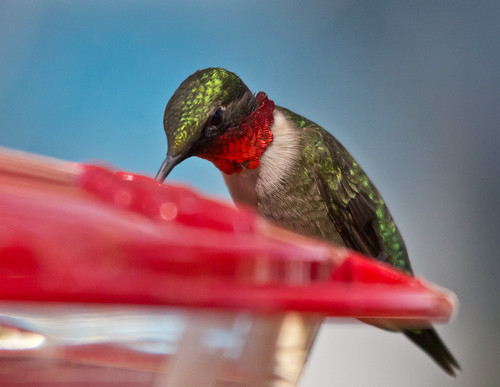Thursday, April 30, 2015
Wednesday, April 29, 2015
Kansas: Wings N Wetlands Birding Festival
 |
| Yellow-headed Blackbird |
As a national wildlife refuge, Quivira is managed by the US Fish and Wildlife Service; the land was purchased in large part thanks to Duck Stamp revenues contributed by birders, Duck Stamp collectors, and hunters, all specifically to protect waterfowl habitat. Cheyenne Bottoms is managed by the Kansas Department of Wildlife, Parks, and Tourism, with a large swath of adjacent habitat owned and managed by The Nature Conservancy.
The drought in 2013 was so devastating that the birding festival had to be cancelled. I still came, and got to see quite a few ducks and shorebirds despite the dearth of water. Now rains have recharged the wetlands fairly well, and it was teeming with shorebirds and lingering waterfowl, especially shovelers and Blue-winged Teal.
The riches of this part of Kansas are not limited to water birds—it’s still early in migration, but I saw at least a dozen exquisite Scissor-tailed Flycatchers on the trip, mostly en route from the Wichita Airport, but one pair at Quivira. The festival field trips were almost entirely limited to Quivira and Cheyenne Bottoms, and we had to race through much of the Friday afternoon field trip with a menacing thunderstorm on the horizon and tornadoes touching down not all that far away, yet between that and Saturday’s trips, I saw 111 species, and added two more on a bonus field trip Sunday morning.
 |
| Massasauga |
All the festival’s field trips combined yielded 149 bird species. The only disappointment with the whole trip is that I got to see so many species without my puppy—Pip missed a lot of lifers!
 |
| Wilson's Phalarope |
 |
| Greater Prairie-Chicken |
Watching and listening to prairie chickens in action is one of my favorite thrills. I took most of my photos and videos of one particular male closest to the blind. He only chased other males who came onto his little defended space. The others in the flock were usually facing off with one another a bit further away. I think this bird was the dominant one, because any time another male approached anywhere near his little dancing ground, he chased it off immediately.
The bird I focused on this year was much closer to the blind than the one two years ago, and there’s little chance that that bird is still alive—Prairie chickens are a relatively short-lived game species, devoured by Golden Eagles and coyotes as well as by human hunters, and are also killed in large numbers in collisions with fences—but I like to think that plucky 2013 bird did make it and was among the birds I watched dancing. It was deeply overcast, so the light was exceptionally poor for photography, but nevertheless I took bazillions of photos and some videos. For me, any look at a Greater Prairie-Chicken is a glimpse into heaven.
Friday, April 17, 2015
Climate Change vs. Wildlife?
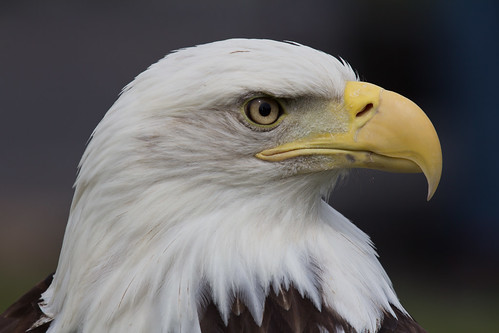 |
I’ve long believed that as critical as it is to find sustainable ways to generate electricity, we must invest in research to ensure that the designs and placements of solar and wind generating plants are the safest possible for wildlife. Unfortunately, the pattern of our capitalistic society is to require research to be profit-driven. And as both of America's political parties have further and further distanced themselves from environmentalism, we wait longer and longer, until foreseeable problems reach crisis levels, and then desperately go full-speed ahead with a few misguided projects. For example, even as corporations create huge mirrored solar plants in quality desert habitat, frying abysmal numbers of birds in the sky or drawing them down to crash into what looks like water, we’re making it harder and harder for homeowners to put up innocuous solar panels on their own roofs, thanks to lobbying by profit-motivated power companies.
I attended a Catholic school as a little girl—that’s where most of my sense of morality and ethics was formed. Jonathan Franzen wrote about his own moral development:
Maybe it’s because I was raised as a Protestant and became an environmentalist, but I’ve long been struck by the spiritual kinship of environmentalism and New England Puritanism. Both belief systems are haunted by the feeling that simply to be human is to be guilty. In the case of environmentalism, the feeling is grounded in scientific fact. Whether it’s prehistoric North Americans hunting the mastodon to extinction, Maori wiping out the megafauna of New Zealand, or modern civilization deforesting the planet and emptying the oceans, human beings are universal killers of the natural world. And now climate change has given us an eschatology for reckoning with our guilt: coming soon, some hellishly overheated tomorrow, is Judgment Day. Unless we repent and mend our ways, we’ll all be sinners in the hands of an angry Earth.
I’m still susceptible to this sort of puritanism. Rarely do I board an airplane or drive to the grocery store without considering my carbon footprint and feeling guilty about it. But when I started watching birds, and worrying about their welfare, I became attracted to a countervailing strain of Christianity, inspired by St. Francis of Assisi’s example of loving what’s concrete and vulnerable and right in front of us. I gave my support to the focused work of the American Bird Conservancy and local Audubon societies. Even the most ominously degraded landscape could make me happy if it had birds in it.My own Catholic education started with the premise that we were not only expected to love but to nurture our fellow creatures. The very first day of first grade, a soft-spoken, gentle priest named Father Ciemega came into our class and asked if anyone knew their ABCs already. I practically leaped out of my desk raising my hand so exuberantly that he couldn't help but call on me. After I recited the alphabet, he gave me a tiny treasure—what we called a "holy card," this one depicting a large hand (presumably God’s) cradling a tiny baby bird. This was a perfect symbol to prove to me that it wasn’t enough to love God’s creatures—we were expected to protect them.
When we learned about sins before making our first confession in second grade, one of the sins they mentioned was one of omission—not taking proper care of our pets—that was a huge moral responsibility. And as I recall, Francis of Assisi was the first saint we learned about in school. Our reader included a story in which he saved the life of a wolf that had been terrorizing a village, by teaching the wolf and the people to get along. So in my gut, the issue of climate change and the issue of protecting wildlife are equal mandates.
Whatever the original source of our personal ethics and whether it involves any God, religion, or other system outside our own ability to reason, it’s frustrating and mystifying to me that anyone can turn their backs on any wildlife population. I’ve been an environmentalist since the very first Earth Day, in 1970, when we were completely committed to getting Congress to pass laws to protect our air, our water, AND our wildlife. We didn’t let the huge problems—Lake Erie being considered dead, the Cuyahoga River catching fire, or toxic smog smothering our cities—draw our focus from endangered and threatened species, nor did our concerns about animals reduce our focus and effectiveness in dealing with urgent issues about the air and water we all need. We didn’t say that without clean water, Bald Eagles and Osprey will disappear anyway.
It’s only been with encroaching corporatism that we’ve watered down our goals of preserving the environment that we and wildlife share. But those of us most knowledgeable and committed to climate issues and those of us most knowledgeable and committed to wildlife issues must work together if we’re ever going to be effective at helping with either issue—the problems are too big and too deep and too tall to tackle while squandering our energy infighting. As Robert Frost might have put it, “environmentalists work together, I told him from the heart, whether we work together or apart.”
Wednesday, April 15, 2015
Migration Update
 |
A small flock of robins arrived in my neighborhood over two weeks ago, searching out old crab apples and dried up buckthorn. I’d occasionally hear their alarm notes, and Pip paid attention to them scuffling through the leaf litter behind our yard, but suddenly one morning last week they were singing away, each one trying to stake out a territory. It was like a switch was flipped—now their songs will be part of the morning soundtrack every day until July. The first day they broke into song, two got into quite a battle, which was interesting enough for me but absolutely fascinating for my little Pip. Every bit of their territory is important, and so now even if we get a late spring blizzard, they won’t want to lose ground and will keep up with the daily singing unless conditions grow dire indeed.
A few days after the robins started singing, Song Sparrows were suddenly in full song. That cheerful tune always lifts my spirits.
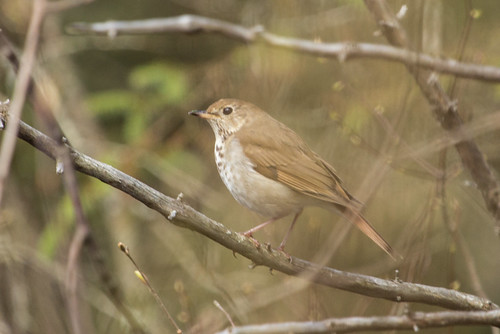 |
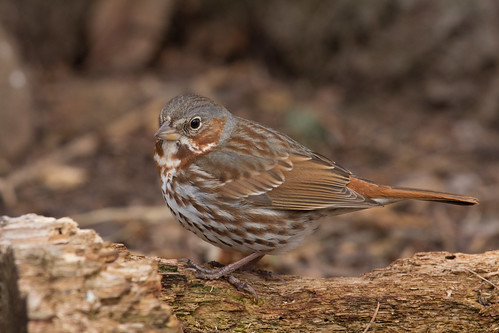 |
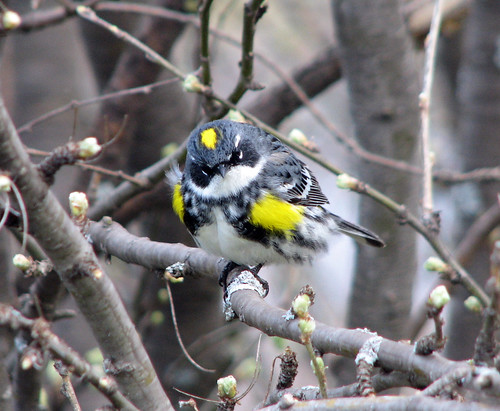 |
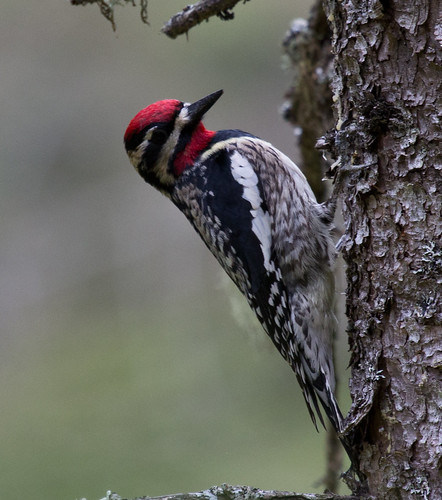 |
By April 14, Pip’s life list was at 60, and will start growing by leaps and bounds now, and I wake up every morning thinking about all the possibilities. It’s the most wonderful time of the year.
Thursday, April 9, 2015
Hummingbirds
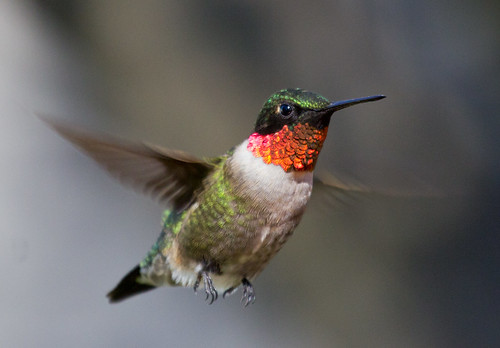 |
| Male Ruby-throated Hummingbird |
The Internet is filled with advice about birds—it can be very difficult for people to figure out what’s accurate. I’ve read all kinds of misinformation about just about every topic imaginable—birdhouse plans specifically designed for cardinals, even though cardinals are not cavity nesters and never ever use birdhouses; photos of panting, stressed captive Snowy Owls ridiculously described as “laughing”; and recommendations to make sugar water super-strong, with a 1:1 ratio of sugar to water, which is a horrible idea.
The sugar water we offer hummingbirds should be of a sweetness comparable to that of natural nectar, which averages about ¼ strength, or a quarter cup of sugar per cup of water. If you want to make things simple, that’s all you need to remember to provide sugar water that will be perfectly fine under any conditions.
Some people insist that their hummingbirds only take beet sugar or cane sugar. I’ve never noticed a difference, and many hummingbird authorities claim there is no difference.
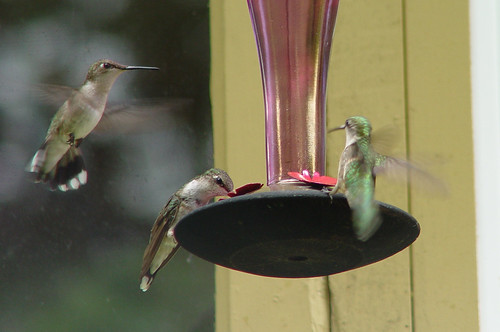 |
| This feeder is filled with clear sugar water; the pinkish glass makes food coloring utterly worthless as well as harmful. |
There is absolutely no reason to color hummingbird water: real flower nectar is clear, and hummingbird feeders have plenty enough red to attract the little birds.
Also, don’t use honey in place of sugar—it clouds up very quickly, getting contaminated by bacteria and fungus.
If you fill your feeders whenever you mix up a new batch of sugar water, there is no need to boil the water first. Even if you mix up a large batch to use as the feeders empty, you don’t need to boil the mixture as long as you put it in a clean container and refrigerate it until use.
Make sure you clean your feeders regularly—use a stiff bottlebrush, and make sure there are no little black deposits in the crevices. The most important feature to consider when purchasing any hummingbird feeder is that it’s easy to clean.
Change the sugar water frequently—every day or two in hot weather. Sugar water slowly ferments, and even if it’s relatively clear, some of the sugar may have been converted to alcohol, bad for hummingbird livers. If it gets cloudy, you’ve waited too long.
Natural flower nectar varies in strength. If you want to fine tune the recipe to provide ideal sugar water for differing situations, you can make it stronger, up to about 1/3 cup of sugar per cup of water, during cold, rainy situations. This can provide added calories during migration when birds are burning up energy as they go, or when we have a cold snap right when hummingbirds are incubating eggs, minimizing the time they must be off the nest. During hot, dry spells when water is at a premium, you can make your mixture weaker—about 1/5 cup of sugar per cup of water—especially if hummingbirds in your neighborhood have little access to drinking water. But again, if this is hard to remember, the basic recipe of ¼ cup of sugar per cup of water is fine in all situations.
Many hummingbird feeders come with little yellow cage things meant to be put over the feeding ports as “bee guards.” These do keep the bees out of the ports, but with some feeder designs, sugar water almost invariably drips onto the bee guards. On these feeders, wasps and bees may actually sit on the guard getting the sugar water off them.
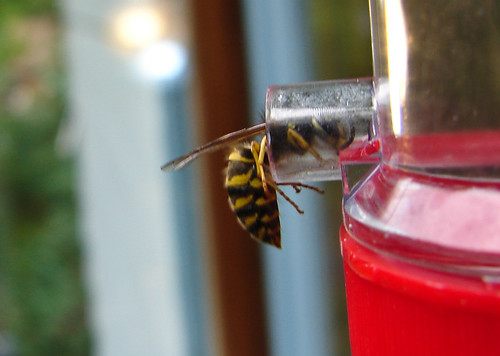 |
| Yellow jackets come to this kind of feeder with or without bee guards. |
One female hummingbird took notice. Within a half hour, whenever a yellow jacket took over the feeder, she started hovering at the window, giving me a long hard stare until I got the vacuum and sucked out the problem wasp. The vacuum was noisy, and if I’d turned it on her, it would have sucked her into it, too, but she seemed utterly unafraid—the whole time I was leaning out the window vacuuming up wasps, she’d hover nearby as if supervising. If I didn’t notice her right away when a wasp took over the feeder, she started actually tapping at the window with her beak to get my attention.
Hummingbirds are so tiny and vulnerable that it always takes me aback how quickly they figure out which people will do their bidding. Every year delighted hummingbird aficionados tell me stories about the hummingbirds that return year after year and look in the window for them. For weighing a mere eighth to a tenth of an ounce—you could mail ten of them with a single stamp—they are astonishingly intelligent and have long memories. Their lives are treacherous, yet some banded Ruby-throated Hummingbirds have lived at least 9 years thanks to their intelligence, which can temper a natural wariness with learned discrimination.
Vacuuming problem wasps is a non-toxic way of dealing with them, but it still made me sad about killing the insects. One of my friends worked out a way of banishing his wasps from his favorite hummingbird feeders: he filled one feeder with a concentrated sugar water mixture with a 1:1 ratio. Wasps prefer far stronger sugar mixtures than hummingbirds do, and so the wasps gravitated to that feeder, leaving the other feeders for the hummers. He moved the wasp feeder further and further from his house, and within a day or two his wasps were in the furthest reaches of his backyard while he enjoyed his hummingbirds and they enjoyed safety. This of course isn’t a good solution if you, your family, or any neighbors are allergic to stings, but was the ideal solution for him.
One kind of hummingbird feeder comes with a built in ant-guard—a moat in the center which should be filled with water. Ants can’t swim, so that keeps them from getting to the sugar water. Where ants are a problem, use that kind of feeder or a hummingbird feeder suspended from a hook with ant guards in place above the feeder. A good ant guard is nothing but a water-filled cup that keeps ants from reaching the feeder below.
Hummingbird feeders are all you need to attract a few hungry migrants passing over. That is as important for them as restaurants are for hungry human travelers. But hummingbirds need a lot more than sugar water to survive. If you want some to stick around your neighborhood beyond migration, you’ll need to build up your backyard habitat.
As more and more of America falls into private hands and more and more public land loses the protections that have guarded our country’s wildlife, our backyards are becoming increasingly critical to provide essential habitat for wildlife. This of course has a dark side as more and more people and their pets encounter predators, hungry but skittish skunks, and other creatures it’s not always easy to deal with—including the wasps I complain about. This problem is growing in part because so many people were never educated, at home or school, about wildlife.
To make our backyard habitat friendly to hummingbirds through the breeding season, we must make sure it provides a balanced diet for adults and the young, a safe place to build a nest, and appropriate nest materials.
During migration and any cold days after resident birds arrive but before flowers open, hummingbirds get essential carbohydrates from sap oozing from tree buds and sapsucker drill holes. Aspens are ideal for being inexpensive, locally native trees that provide both, and may draw sapsuckers away from more expensive ornamental trees, to boot. In our area, the number one factor that makes it likely that hummingbirds will nest nearby is a resident Yellow-bellied Sapsucker.
Nectar-bearing flowers are also great invitations to hummingbirds. Choosing species and cultivars native to our area will ensure that good insects are attracted to them, too—hummingbirds need a lot of protein, both for the adults and for growing nestlings, and tiny insects provide all of this. Jewelweed, columbine, and lots of other flowers are ideal.
Carrol Henderson’s Landscaping for Wildlife, published by the Minnesota DNR, is a great book for giving plant suggestions for our area. When you purchase flowers for your yard, make sure no systemic pesticides were used on them.
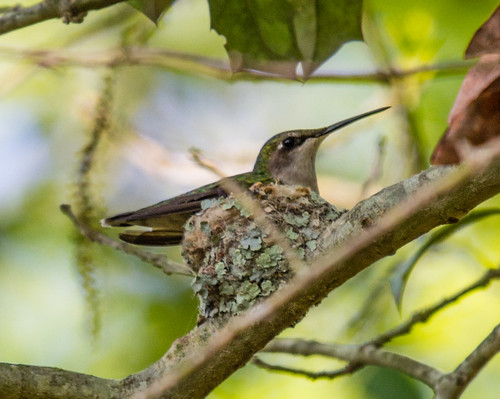 |
| The lichens making this nest both strong and camouflaged are held together with spider silk, which also holds the nest to the branch. The nest will stretch to accommodate the growing young. |
Every year I like to anticipate hummingbird arrival, so I check the internet map on Hummingbirds.net starting in February when more and more suddenly appear along the Gulf Coast. Throughout March and April, they continue to advance. The man who puts together the map, Lanny Chambers, uses a different color each month to make the progress more clear. As of April 9, there had already been a few sightings in central Indiana and several in Illinois along the Mississippi River. As the month proceeds, you can watch the sightings creeping northward.
It’s fine to set out your feeders a few days before they arrive so the very first ones don’t have trouble finding food, but make sure to keep the sugar water fresh. Reporting your own sightings to hummingbirds.net and also to ebird.org will help scientists track this information, which is useful for many conservation and education purposes. But even if you don’t report your own sightings, enjoy the ones at hummingbirds.net so you can get your feeder out as soon as hummingbirds appear up here. Meanwhile, just thinking about them may warm your heart.
Wednesday, April 1, 2015
My new bionic ears! (Well, actually, my hearing aids.)
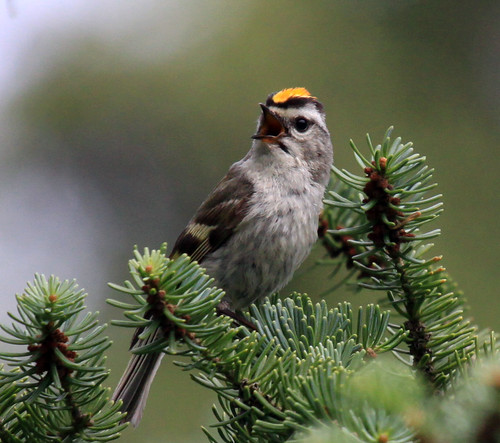 |
| Golden-crowned Kinglet |
Every year or two, I need new eyeglasses. My deteriorating
vision isn’t very noticeable from day to day or month to month, so when I put
on a new pair of glasses, the clarity always surprises and satisfies me. My
near vision is still fairly good, so at home I hardly ever wear glasses. I can
recognize most of my normal birds out the window without glasses or binoculars,
not because I can see any nuances in plumage but because I have so much
experience looking at them that I recognize the usual suspects by size,
behavior, and general color patterns. It’s pretty much the way we can recognize
a stop sign from quite a distance, unless our vision is really bad. We may not
be able to actually read the letters or see the corners to be sure the shape is
an octagon, but stop signs tend to be in the exact same position on street
corners, and no other signs are that color and general shape. My glasses help
me read all kinds of signs, and I can enjoy the nuances of bird plumage,
especially when brought even closer with binoculars.
Although hearing is every bit as important as vision in some
endeavors, from music to birding, we tend to ignore hearing loss way more
easily than we ignore deteriorating vision. For at least a decade, I’ve been
noticing that I’ve lost acuity in my high frequency hearing. I still hear the
vast majority of bird songs other people do, but now can only pick up the
highest frequency songs—Golden-crowned Kinglets, Brown Creepers, Blackburnian
Warblers, etc.—if the birds are very close. Two years ago I actually watched a nearby
Golden-crowned Kinglet singing away, but I couldn’t hear a single note. And last
winter when I was mixing a radio program using a Cedar Waxwing recording I’ve
used many times over the years, I could not hear any of the middle section of
the recording, even though I knew exactly what it was supposed to sound like.
It was time to face up to the truth, and on March 25, I finally did it—I got hearing
aids.
I didn’t know quite what to expect when the audiologist
helped me put them in, but at first I couldn’t even tell if they were working.
In the same way that I can see anything around the house without my glasses,
and nearby things look almost identical with or without my glasses, sounds in
my audiologist’s quiet office sounded virtually identical with and without my hearing
aids. The one thing that was noticeably different was my own voice—I was
hearing it resonating inside my head like always, but also hearing it a bit closer to how it sounds to
other people. Hearing my own voice like that is something I deal with all the
time when producing my radio show, so it didn’t seem like that big of a deal. I’m
sure if my hearing was worse, I’d have appreciated more differences right off,
but for me the immediate change was subtle.
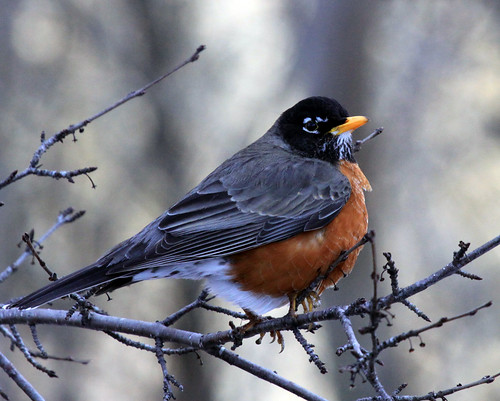 |
When my mother-in-law and I were leaving her audiologist
after she got hearing aids for the first time, a robin was singing, and she
said that was the first robin she’d heard in years. Oddly enough, she didn’t
think that had anything to do with the hearing aids—she said that robins just
didn’t live around her place in Port Wing, even though I heard them every time
I was there in spring and summer. So far, I’ve never had trouble hearing robins,
but with my hearing aids in, their song is clearer and lovelier again—the way
they were when I was in my 20s. Apparently, little by little I’d lost the high
frequency harmonics that give the song some brilliance, even as I heard the
midtones just fine.
When you get two digital hearing aids with directional
microphones, like mine, the programming allows the hearing aids to work
together to detect and suppress background noise even as they augment bird
songs and human voices. In my own backyard, the basic background
noises—people’s furnaces, chain saws, cars and trucks, wind, doors slamming,
and more—seem to have grown louder as the basic bird songs grew quieter. Now,
with my hearing aids, I feel like I’ve gone back in time to when I was a new
birder, when it was so easy to pick out each different sound. Only it’s even better
now, because I have so much more experience at recognizing the sounds while now
getting so much pleasure in hearing them so clearly again. Like getting a new
pair of glasses, my world is suddenly crisper and more brilliant—only in the
auditory rather than visual realm.
Watching TV is much more enjoyable now, and listening to the
radio in the car is wonderful. The volume and people’s voices don’t sound very
different when I take the hearing aids out or put them back in again, yet with
them in, I hear the enunciation much better. I also hear bird recordings much
more clearly.
Next week my audiologist will be making a few tweaks on the
programming for when I’m using the hearing aids specifically for birding, and
soon the first kinglets, creepers, and waxwings will return so I can test how
well they work for that. I’ll also be testing another kind of hearing aid
specifically designed for birders—one that lowers the frequency of high-pitched
sounds. It’ll be interesting to see which I prefer when looking for
hard-to-hear species like Le Conte’s Sparrows. But so far my bionic ears are a complete
success.
(I have not compared different brands and models of high quality digital hearing aids. Mine are the Phonak Audéo V90.)
(I have not compared different brands and models of high quality digital hearing aids. Mine are the Phonak Audéo V90.)
The true story of Don Draper and how Mad Men will end
(This is a transcript of today's radio program which you can hear here.)
On April 5, the final season of Mad Men will begin. Almost from the beginning, people have been
speculating about how the popular series will end, though like Dorothy’s ruby
slippers, the answer was right before us from the very start. Don Draper’s existential
crisis was encapsulated right into the series credits, showing the adman in
free fall, drifting down down down until right when it looks like he’s going to
crash, we realize our perspective is all wrong, and he’s landed safely, on the
outside of that terrifyingly empty, materialistic world.
What hardly anyone knows is that Matthew Weiner’s iconic
character is based on the life of a real person. By the mid-70s, Dick Whitman,
aka Don Draper, had entirely given up the essential falseness and materialism of
the advertising world for the natural world. Yes, it’s true. Don Draper left
advertising to become a birdwatcher, first doing pro bono work for the Audubon
Society and then spending his final years in the mountains of California
protecting California Gnatcatchers and the last wild condors.
I have here in the studio some of the only people on the planet
who know the true story. We’ll start with me, because in fact, I not only knew
the real Don Draper, but I’m his daughter. You heard that right—Laura Erickson
is the real Sally Draper. During my freshman year of
college, I got active in the 1973 Earth Day celebration. My best friend, Glen Bishop, got active in
environmental issues in high school and college, so naturally I did, too. But
the thing we cared most about was wildlife, and by April 1973 we were very
frustrated that we’d not made much progress at all on getting an Endangered
Species Act passed. So I talked to my dad, who was reaching a crisis in his
marriage to Megan and hated advertising and everything else about
his life. He was desperate to find something true to believe in. When I asked
him if he could help us find some effective ways of persuading someone to
introduce the bill in the Senate, he grabbed at the opportunity like a
lifeline.
HENRY FRANCIS: I’m Henry Francis. I married Sally’s mother
in 1964. Don and I hated each other for a long time, but despite his character
flaws, we grudgingly grew to respect each other. When Sally asked him for help
with getting the Endangered Species Act through Congress, he turned to me. I’d
been quite influential in New York state politics, and he thought my
connections could help. I didn’t know anyone in New York who would be willing
to get embroiled in the controversial act, but was good friends with Pete
Williams, the New Jersey senator who had already made a reputation with his
controversial Coal Mine Safety and Health Act and Urban Mass Transportation
Act. Pete was the one who introduced the
Endangered Species Act. Don got so involved in that, and was so happy to earn
Sally’s respect, that he started working pro bono for the Audubon Society to
educate the public about endangered species.
SALLY DRAPER: His helping with the Endangered Species Act
marked a sea change in my relationship with both my parents. My mom and Henry
started treating me with more respect, and my dad and I grew very close, and
stayed that way from then on.
SALVATORE ROMANO: I’m Salvatore Romano, former art director
at Sterling Cooper. The 60s were a horrible time for a gay man in New York, or
really just about anywhere. Lee Garner Jr. from Lucky Strike made a pass at me—Garner
was a repulsive man in every way, but he held so much power over Sterling
Cooper that I tried to be as polite as possible when I turned him down. But he demanded
that the agency fire me, and Don went along, even making a cutting remark about
“you people” to me. I was devastated. I disappeared into the seamiest elements
of New York City’s gay community, and I even fell into the drug
scene for a while. Matthew Weiner didn’t go into it in the TV series, but it
was Don Draper who pulled me out. He’d been having horrible nightmares about
his dead brother—he told me he was tired of being the cause of so much
devastation, and he begged me to let him help me since he’d played a part in my
problems, too. He bought me a first class ticket to San Francisco and used his
connections to set me up with some great job interviews, and even paid for a
couple of suits and a visit to his barber so I’d make a good impression. I’d
long since lost my portfolio, but he dug up a lot of my work and put it all
together to make me look pretty impressive.
If you didn’t want to hide in the closet, San Francisco was
way better than New York for a gay man back then. Thanks to Don, I got a great job
as an art director in the theater community, doing the kinds of real art that
an adman only dreams of. That got me involved in the local theater scene, too—after
a lifetime of misery, I was in heaven. Plus I crossed paths with the man who
has now been my partner for decades. Edward is one of the least artistic gay
men in the world—of all things, he was a birder, happiest out hiking in some godforsaken
landscape watching condors or tiny little gnatcatchers—but somehow we both
expanded each other’s worlds and settled into a very happy life together. When
Don started promoting endangered species, he looked up Edward and that’s how he
and I reconnected. Don Draper was certainly messed up for a while, but he was
one of the most fundamentally decent human beings I’ve ever known. I was proud
to be his friend up to the very end.
JIM BAKER: This is me, Jim Baker. I was a copywriter at McCann
Erickson in the early 70s. I thought I was the only birder in the New York
advertising world until one day during spring migration, out of the blue, who
do I run across in Central Park but Don Draper, looking up at a Cerulean
Warbler. Yep, he got me my lifer! This was 1975, and
by then he was out of advertising and doing work for the Audubon Society. Don
was still pretty much bicoastal at that point, but whenever he was in town,
we’d meet in Central Park before work. When I couldn’t take that life anymore
in the 80s, it was Don who helped me move my stuff up to Lake Superior to start
Baker’s Blue Jay Barn. And whenever he couldn’t hack how his life was going,
he’d hole up with me in the North Woods for a little R&R with Nature’s
Perfect Birds. By then neither of us had a telephone, but we wrote each other
about our bird sightings every Sunday. One week, his letter didn’t come. He was
working on his California Gnatcatcher project, and I knew some rich landowners
had threatened him, so I flew out. It was me who found his body—well, what was
left of it.
EARTH ANGEL: I’m
Earth Angel. My real name, of course, is Suzanne Farrell: I was Sally Draper’s
teacher. That was when Don’s marriage to Betty was falling apart, and it was a
very bad time for both of us. I stuck with teaching in Ossining for a few more
years, but after reading Silent Spring, I started working on environmental
issues and moved out to Oregon to do Spotted Owl work with my brother. Don and
I reconnected when he was helping Sally on the Endangered Species Act.
SALLY DRAPER: At first I hated that—it gave me the
creeps that my dad had had a relationship with my teacher and now was hooking
up with her all over again! But by then I was starting to see that even though
he was so messed up about women, my dad was a good guy, and Miss Farrell—I mean
Suzanne—was good for him and made him happy.
EARTH ANGEL: After Jim Baker found Don’s body, hundreds of
people came out of the woodwork to tell us how Don had changed their lives. We
received millions of dollars in contributions.
JIM BAKER: He never wanted any recognition for himself, so
we earmarked all the money to Don’s three pet projects: the Adam Whitman Environmental
Education Center in Illinois on the old farm site where Don spent his early childhood; the Lane Pryce National Wildlife Refuge and Jaguar
Protection Project in southeastern Arizona; and of course, the Bert Cooper Theater
in San Francisco.
EARTH ANGEL: Don explained all about Bert Cooper. After
Cooper died, his spirit started appearing to Don, always singing and dancing.
At first Don thought he was hallucinating, but little by little, he came to
realize that this really was the spirit of Bert Cooper. Bert Cooper
was sharing with his protégé his after-death realization that Ayn Rand was
wrong. How we deal with our fellow travelers, animal and human, on this
beautiful planet is how we are measured as human beings. That’s it. Don Draper spent
the rest of his life trying to live up to that simple message.
SALLY DRAPER: And that’s the true story of my dad, Don
Draper, aka Dick Whitman. You’ll find out all about it when Mad Men starts up
again, at least if Matthew Weiner sticks to the truth.
****
With the voice talents and support of Brad Adams, John Keenan, Karen Keenan, and Kat Steffens, and artwork by Michael Geraci.
Subscribe to:
Comments
(
Atom
)


